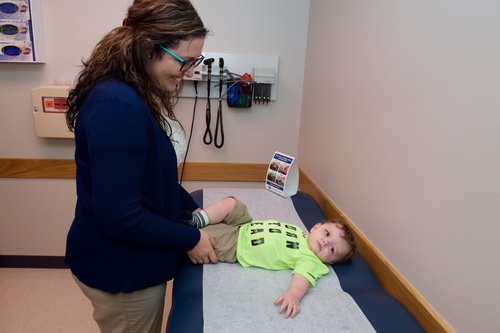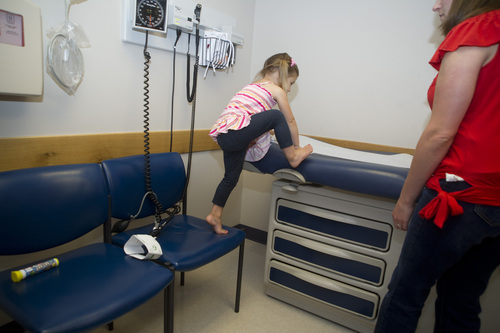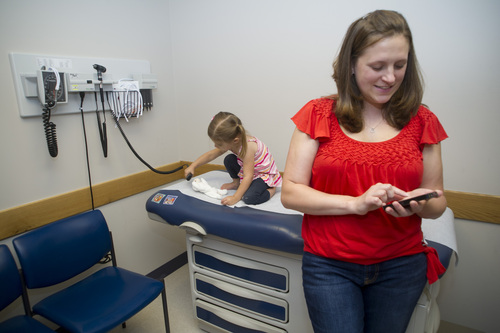
Table tents, like the one seen on the back of this exam table, remind parents and staff to never leave children unattended on exam tables. The table tents are part of the hospital’s fall prevention practices to reduce patient falls and serious injuries in outpatient offices.
Akron Children’s was recognized by the Joint Commission, a voluntary accrediting organization, for its practical fall prevention practices in ambulatory settings. Since patient falls are one of the most preventable serious safety events that occur in hospitals, Joint Commission accredited hospitals are required to develop fall prevention programs for their patients, regardless of age.
“The American Academy of Ambulatory Care Nursing Association (AAACN) has highlighted our practical solutions as an example of how any organization can develop and implement a fall prevention program,” said Annette Hamlin, nursing professional development specialist. “We have been represented at the AAACN 2021 Conference, 2021 Nursing Sensitive Indicator Chat, and will soon be featured in their publication, Viewpoint.”
Although Akron Children’s has long had fall prevention practices in place for inpatients, Annette says many of them don’t translate to an outpatient setting.
“We screen inpatients for fall risk and use interventions like bed rails or put a ‘fall risk’ sign on their room door,” she said. “We can’t do that with outpatients, so we had to look at other methods.”
With limited literature in existence to support evidence-based practice, a group of nurses within the hospital’s Ambulatory Shared Governance Council met to examine the problem.

Data shows significant injuries occur when children fall off exam tables in physicians’ offices.
“When looking at different ambulatory departments’ incident reports, we were surprised to discover we had more falls than our inpatient areas,” said Annette. “The first year of data showed some serious injuries like concussion, sutures and rib and skull fractures. That was eye-opening because no one comes to a doctor’s office to have their child get injured.”
A multi-disciplinary team searched the evidence and formulated measures to prevent significant injury in the offices. The committee reached out to the AAACN community to see what they were doing to help prevent falls in ambulatory settings.
“We saw some practical solutions that others used and were able to build upon them,” said Annette. “We developed an evidence table and extrapolated pertinent and successful ideas to help formulate an ambulatory care fall prevention plan.”
Data showed significant injuries were occurring when children under age 5 either fell or rolled off exam tables in physicians’ offices.
“This was consistent in our incident reporting system and also reflective in the national pediatric evidence,” Annette said.

One of the biggest reasons for patient falls in outpatient settings is caregivers who are distracted.
In addition to falls off exam tables, data showed some significant injuries also occurred in waiting areas.
“Parents or caregivers are present at appointments, but it doesn’t necessarily mean they are closely watching the child,” said Annette. “That was the case when a child climbed on top of a Little Tikes playhouse and jumped off onto a concrete floor resulting in a significant injury in one of our waiting rooms.”
Annette says although patient service representatives at the front desks often observed unsafe behavior, they were uncomfortable interceding and stepping on parents’ toes.
“We knew we had to develop some standard work that would help them find the right words,” she said. “Now they are taught to say, ‘We care about your child’s safety, please help us keep your child safe from falling by not allowing him to do X.’”
Data from 2013 showed 7 falls in ambulatory offices that had moderate to severe injury. After the addition of some targeted measures, subsequent years had a decrease to zero falls with moderate to severe injury. Work to improve the fall prevention program is ongoing.

To help prevent serious falls, babies should be buckled in their carriers and placed on the floor. Older children should remain seated in a chair or on a caregiver’s lap until the provider enters the exam room.
Practices that are now a standard part of outpatient fall prevention include:
- Making sure staff has a parent’s full attention when reviewing safety rules.
- Reminding parents to keep babies buckled in their carrier, especially after weighing and measuring.
- Reminding caregivers not to place baby carriers on exam tables. Carriers should always be placed on the floor.
- No children are to be left on the exam table unattended.
- Use of table tents on exam tables to reinforce the message to not place the child or the carrier on the exam table and to remind staff to have safety conversations with families.
- Having kids and teens sit for a few minutes after vaccines and lab draws to make sure they aren’t lightheaded.
“We educate staff at new employee orientation that patient safety is everyone’s job,” said Annette. “Working with pediatrics, we know we will never eliminate all falls, but the goal is to minimize the serious ones.”










